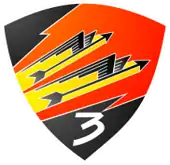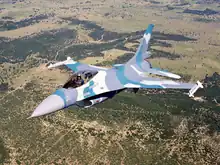3rd Air Squadron (Indonesia)
The 3rd Air Squadron (Indonesian: Skadron Udara 3 or SkU 3) is a Fighter Squadron of the Indonesian Air Force (TNI-AU) under the command of the 3rd Air Wing, headquartered in Iswahyudi Air Force Base.
| 3rd Air Squadron | |
|---|---|
| Skadron Udara 3 | |
 | |
| Active | 21 March 1951–present |
| Country | |
| Branch | |
| Type | Fighter |
| Part of | |
| Garrison/HQ | |
| Nickname(s) | Dragons |
| Motto(s) | "Uruvikrama Ghataka" (Valiant and Deadly) |
| Engagements | Darul Islam Rebellion Permesta Rebellion Konfrontasi Operation Trikora Operation Lotus Operation Integrated |
| Website | tni-au |
| Commanders | |
| Current commander | Pandu Eka Prayoga |
| Aircraft flown | |
| Fighter | General Dynamics F-16A/B/AM/BM/C/D Fighting Falcon |
The 3rd Air Squadron is one of the oldest squadrons and the 3rd squadron formed by President Sukarno on March 21, 1951.
Aircraft flown by the 3rd Air Squadron are, P-51D Mustang (1950 - 1975), OV-10F Bronco (1976 - 1989) and now operating F-16 Fighting Falcon A/B (1989 - Present) F-16 Fighting Falcon C/D (2014 - Present),[1] and F-16AM/BM since 2020 (upgraded F-16A/B).
P-51 Era
Indonesia acquired 26 P-51Ds from the departing Royal Netherlands East Indies Army Air Force in 1949–1950 and later received 35 P-51Ds from the United States in 1960–1961.[2]
The Mustangs were used against numerous rebellions during the 1950s, such as the CIA-backed Permesta rebels in 1958–1961. During this period, the Mustang scored the first and (As of 2023) the only aerial victory of the Indonesian Air Force, when on 18 May 1958, a P-51D Mustang piloted by Capt. Ignatius Dewanto shot down a Permesta's Revolutionary Air Force B-26 Invader piloted by Allen Lawrence Pope near Ambon. Pope were later released in exchange for 10 Lockheed C-130 Hercules, making Indonesia the first C-130B operator outside the US.[3][4]
They were also used against Commonwealth (RAF, RAAF, and RNZAF) forces during the Indonesian confrontation in the early 1960s.
As most P-51 in the 3rd Air Squadron are not safe to be flown again, Indonesia received a shipment of six Cavalier II Mustangs (without tip tanks) delivered in 1972–1973 as part of "Peace Pony" program under Mutual Defense Assistance Act. The last time Mustangs were deployed for military purposes was during "Wibawa V" exercise in Mount Lawu, Magetan in February 1975. The Indonesian Mustangs were also used for filming Janur Kuning which was released in 1980. The Mustangs were replaced in 1976.[5][6][7][8]
OV-10 Era
The OV-10 Bronco started her service in Indonesia on 28 September 1976 when 16 OV-10Fs replaced 3rd Air Squadron’s P-51D Mustang.[9]
The OV-10 saw combat in East Timor where it was used as attack aircraft, some OV-10 were piloted by American pilots in bombing raids against Fretilin.[10][11]
In 1990, the Bronco was re-assigned to the 1st Air Squadron and to the 21st Air Squadron later, while the new F-16s were assigned to 3rd Air Squadron. After a fatal crash in 2007, all OV-10 were retired and replaced by EMB-314 Super Tucano.[12][13]
F-16 Era

The Indonesian F-16A/B procurement program was named the "Peace Bima Sena I". Four F-5 Tiger II Pilots Lt. Col. Wartoyo (Marsdya TNI), Major Basri Sidehabi (Marsdya TNI), Major Eris Herryanto (Marsdya TNI), and Major Rodi Suprasojo (Marsda TNI).
Those who had more than 1,000 flying hours departed Indonesia at the end of 1988. They went to the US to receive education and training on the characteristics and uniqueness of aircraft, maneuvers, how to fly, and education to become instructors for the F-16 Fighting Falcon. Apart from the four pilots, 63 technicians also departed after going through the selection process.
The first 2 F-16 landed at Iswahyudi on December 11 1989, after going through a long and tiring journey from the manufacturing plant in Forth Worth, Dallas. The total number of F-16A/B block 15 Operational Capabilities Upgrade (OCU) aircraft owned by the Indonesian Air Force is 12 aircraft. The first pilot conversions opened five months later in April 1990 and by 1999, the 3rd squadron had 31 F-16 pilots.
3rd squadron took part in various air defense operations, operational command level exercises, force level exercises and joint exercises. Joint exercises that have been carried out are Pitch Black exercise in Australia, Elang Thainesia with Thailand, Elang Ausindo with Australia, Cope West with US PACAF, Elang Malindo with Malaysia and Elang Indopura with Singapore as well as visits to friendly countries such as Thailand, Singapore and Australia.[14]
F-16 grant from the US Government

In 2011 it was announced that Indonesia will acquire 24 regenerated ex-USAF F-16s along with spare parts, donated by the Obama administration, Indonesia pays under $750 Million for upgrades and regeneration, the program was named "Peace Bimasena II".
The 3rd squadron received 8 of the 24 F-16, the rest was placed in other squadrons.
The Hill AFB Ogden Air Logistics Complex located in Utah carried out the upgrades. The upgrades brought the F-16s up from the Block 25 to the Block 52 standard with the Indonesian press reporting an upgraded AN/APG-68 (V) fire control radar and Block 52 Link 16 datalink, AN/ALQ-213 Electronic Warfare Management System, ALR-69 Class IV Radar Warning Receiver, a Modular Mission Computer Version 5 and ALE-47 Countermeasures Dispenser Set.[15]
The regenerated F-16s consisted of 19 single seat C variant and 5 double seat D variant delivered to Iswahjudi Air Force Base on July 20 2014 from Hill Air Force Base in Utah, stopping in Guam, Hawaii, Alaska and refueled numerous time in the air. 16 of the F-16s placed in 16th Air Squadron based in Pekanbaru and 8 F-16 were placed in the 3rd Squadron, however, this may have changed as some F-16s were moved to the 14th Air Squadron based in Iswahjudi to fill gap in the squadron.
The first 3 F-16 under this program landed at Iswahjudi AFB on 25 July 2014.[14]
Elang Biru aerobatic team

The Aerobatic Team Elang Biru or Blue Falcon was formed in 1994 and active in 1995. The team flies 6 F-16 from the 3rd squadron in a special blue and yellow livery with red and white stripes and is one of only 3 F-16 aerobatics team, the other being USAF Thunderbirds and RSAF Black Knights.
The Blue Falcon pilots were invited by USAF Thunderbirds aerobatic team to witness their performance at Singapore Airshow 1994, during the airshow, they had the opportunity to discuss with Thunderbirds pilots about their aerobatic training methods, from that discussion, they realized forming an aerobatic team is not easy. Regardless, preparations for the formation of the Blue Falcon aerobatic team were still being carried out by preparing six F-16, consisting of four aircraft as the main formation and two aircraft as solo aircraft.[16][17][18]
By imitating the maneuvers of The Thunderbirds via video, the 3rd Air Squadron team practiced and studied the maneuvers that would be performed for four months. They made their first debut in April 1995 during the Air Force's 49th anniversary, then again in October 1995 during the TNI 50th anniversary, both were performed at Halim Air Force Base, they performed at Indonesian Air Show (IAS) in 1996 at Soekarno-Hatta International Airport, Jakarta. The team made its international debut in Singapore Air Show 1996.[16][17][18]
To increase the ability and variation of aerobatics, in June 1995 they invited three Thunderbirds instructors, they were Major Peter McCaffrey (solo specialist), Captain Matthew E. Byrd (wing specialist) and Colonel Steve "boss" Trent, former Leader of The Thunderbirds. Unfortunately, the training could only be attended by four 3rd Air Squadron pilots, this is because one of the members went to the US to receive education and another were reassigned to the 14th Air Squadron to fly the F-5E/F Tiger II. After the training, they performed at the TNI 50th anniversary. Before they performed at Indonesian Air Show 1996, they performed at a small airshow in their base at Iswahyudi AFB.[16][17][18]
The name Blue Falcon came from the aircraft they fly, the F-16 Fighting Falcon, while Blue is the color of the sky and the color that reflects the Air Force, Elang Biru is the Indonesianization of Blue Falcon. Unfortunately, the team only existed for just over 5 years as the team was disbanded in 2000.[16][17][18]
In 2001 the team was merged with the Jupiter Aerobatics Team, forming Jupiter Blue. The team flies 2 F-16, 3 Hawk 53, and 1 Hawk 109. Now the team is known as the Jupiter Aerobatics Team and flies KT-1B trainer aircraft.
References
Citations
- "Selamat Datang di Lanud Iswahjudi". 2014-09-10. Archived from the original on 2014-09-10. Retrieved 2023-06-30.
- "Arms Trade Registers". Stockholm International Peace Research Institute. Retrieved 5 October 2022.
- "Tahukah Anda? Indonesia Negara Pertama Yang Mengoperasikan Pesawat Hercules Selain AS". Tribun News. Retrieved 18 July 2023.
- Conboy, Kenneth; Morrison, James (1999). Feet to the Fire CIA Covert Operations in Indonesia, 1957–1958. Annapolis: Naval Institute Press. pp. 132–141. ISBN 1-55750-193-9.
- Cavalier Mustangs Archived 27 September 2007 at the Wayback Machine Mustangs-Mustangs. Retrieved: 12 April 2007.
- "Indonesian Air Arms Overview" Archived 16 September 2011 at the Wayback Machine Scramble: Dutch Aviation Society. Retrieved: 12 April 2007.
- "Kisah pilot TNI AU tembak jatuh pesawat pengebom CIA". merdeka.com (in Indonesian). 11 September 2014. Retrieved 2019-08-10.
- "Story: Sepenggal Kisah Generasi Terakhir Penerbang P-51 Mustang TNI AU". radarmiliter.com (in Indonesian). 15 July 2019. Retrieved 5 October 2022.
- "1/48 Testors Indonesian OV-10F Bronco". Aircraft Resource Centers. Retrieved 26 July 2023.
- "East Timor: Acceptable Slaughters". MontClair.
- "The Role of Indonesian National Air Force (TNI-AU) in Seroja Operation in East Timor (1975-1979)" (PDF). International Journal of Culture and History.
- "1/48 Testors Indonesian OV-10F Bronco". Aircraft Resource Centers. Retrieved 26 July 2023.
- "Air Force to purchase 16 Super Tucano fighters". The Jakarta Post.
- "ABOUT". Skadron Udara 3. Archive.
- "Indonesia F-16 Peace Bima-Sena". Retrieved 1 July 2023.
- "Selamat Datang di Lanud Iswahjudi". 2014-09-10. Archived from the original on 2014-09-10. Retrieved 2023-06-30.
- "Elang Biru". Retrieved 30 June 2023.
- "Cerita Awal Pembentukan Tim Aerobatik TNI AU Elang Biru". Airspace Review. Retrieved 15 July 2023.